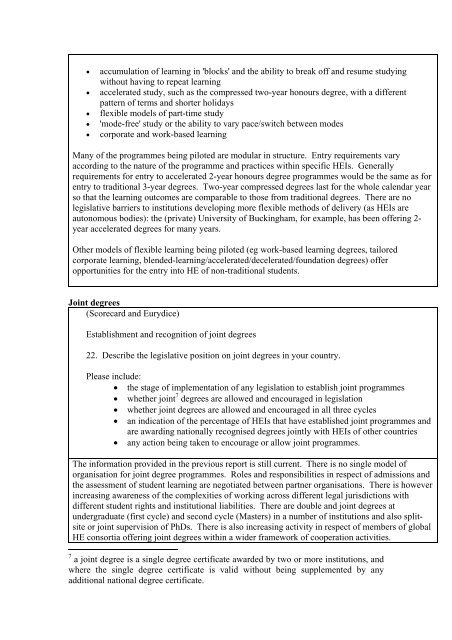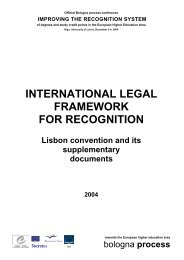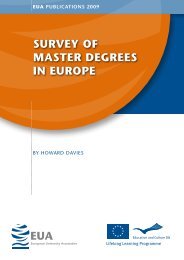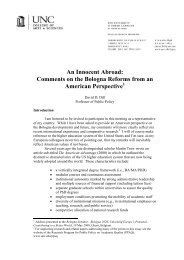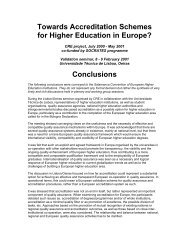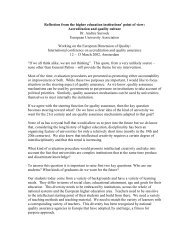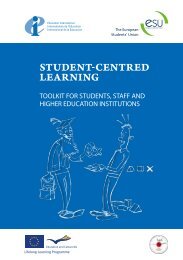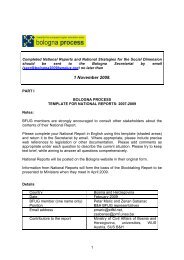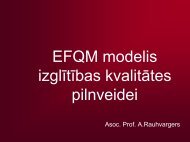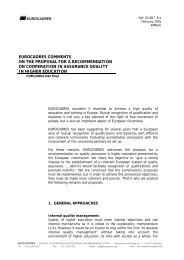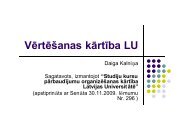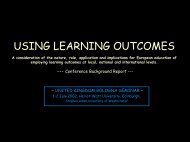BOLOGNA PROCESS - UK England, Wales & Northern Ireland
BOLOGNA PROCESS - UK England, Wales & Northern Ireland
BOLOGNA PROCESS - UK England, Wales & Northern Ireland
You also want an ePaper? Increase the reach of your titles
YUMPU automatically turns print PDFs into web optimized ePapers that Google loves.
• accumulation of learning in 'blocks' and the ability to break off and resume studyingwithout having to repeat learning• accelerated study, such as the compressed two-year honours degree, with a differentpattern of terms and shorter holidays• flexible models of part-time study• 'mode-free' study or the ability to vary pace/switch between modes• corporate and work-based learningMany of the programmes being piloted are modular in structure. Entry requirements varyaccording to the nature of the programme and practices within specific HEIs. Generallyrequirements for entry to accelerated 2-year honours degree programmes would be the same as forentry to traditional 3-year degrees. Two-year compressed degrees last for the whole calendar yearso that the learning outcomes are comparable to those from traditional degrees. There are nolegislative barriers to institutions developing more flexible methods of delivery (as HEIs areautonomous bodies): the (private) University of Buckingham, for example, has been offering 2-year accelerated degrees for many years.Other models of flexible learning being piloted (eg work-based learning degrees, tailoredcorporate learning, blended-learning/accelerated/decelerated/foundation degrees) offeropportunities for the entry into HE of non-traditional students.Joint degrees(Scorecard and Eurydice)Establishment and recognition of joint degrees22. Describe the legislative position on joint degrees in your country.Please include:• the stage of implementation of any legislation to establish joint programmes• whether joint 7 degrees are allowed and encouraged in legislation• whether joint degrees are allowed and encouraged in all three cycles• an indication of the percentage of HEIs that have established joint programmes andare awarding nationally recognised degrees jointly with HEIs of other countries• any action being taken to encourage or allow joint programmes.The information provided in the previous report is still current. There is no single model oforganisation for joint degree programmes. Roles and responsibilities in respect of admissions andthe assessment of student learning are negotiated between partner organisations. There is howeverincreasing awareness of the complexities of working across different legal jurisdictions withdifferent student rights and institutional liabilities. There are double and joint degrees atundergraduate (first cycle) and second cycle (Masters) in a number of institutions and also splitsiteor joint supervision of PhDs. There is also increasing activity in respect of members of globalHE consortia offering joint degrees within a wider framework of cooperation activities.7 a joint degree is a single degree certificate awarded by two or more institutions, andwhere the single degree certificate is valid without being supplemented by anyadditional national degree certificate.


